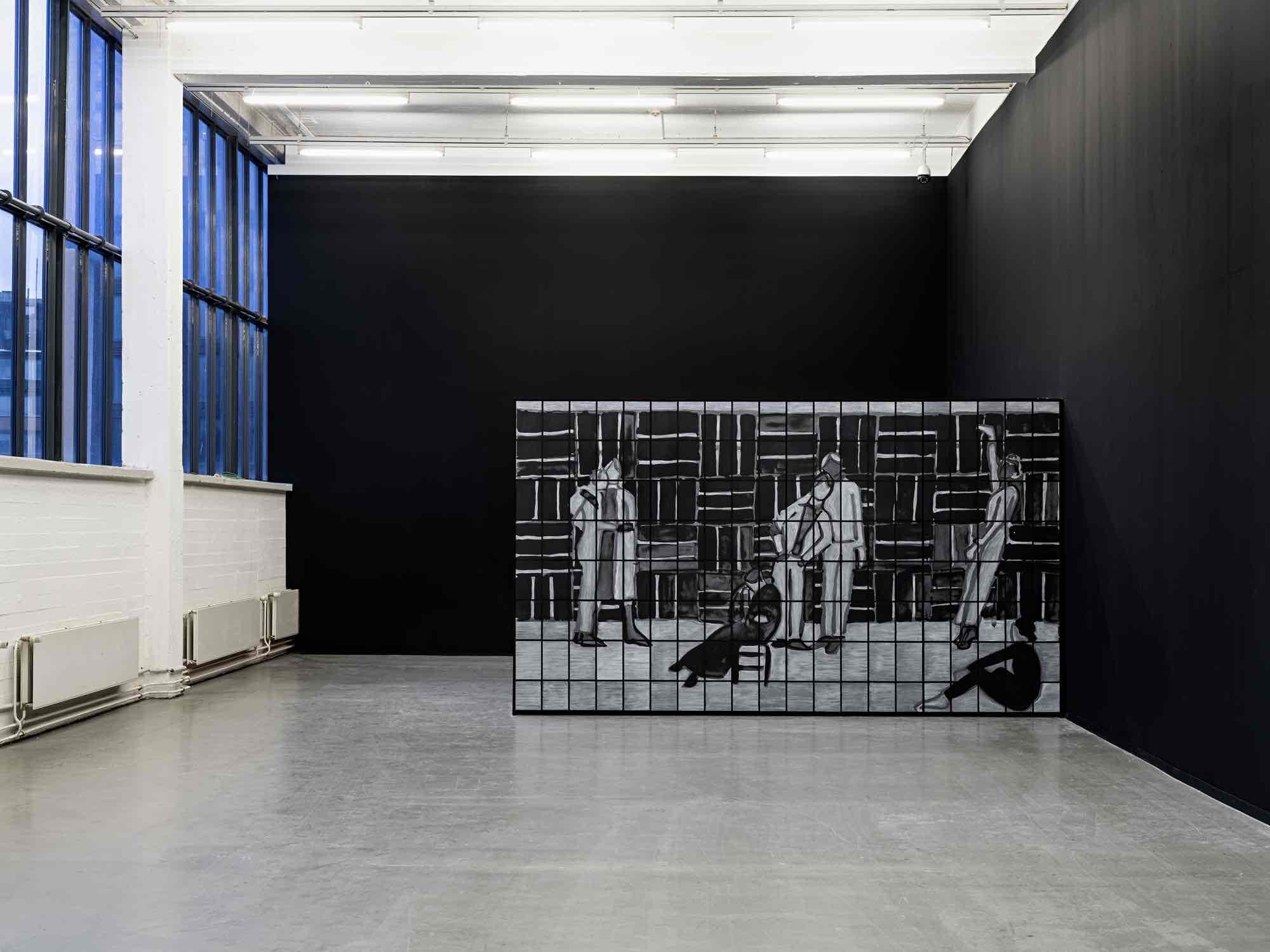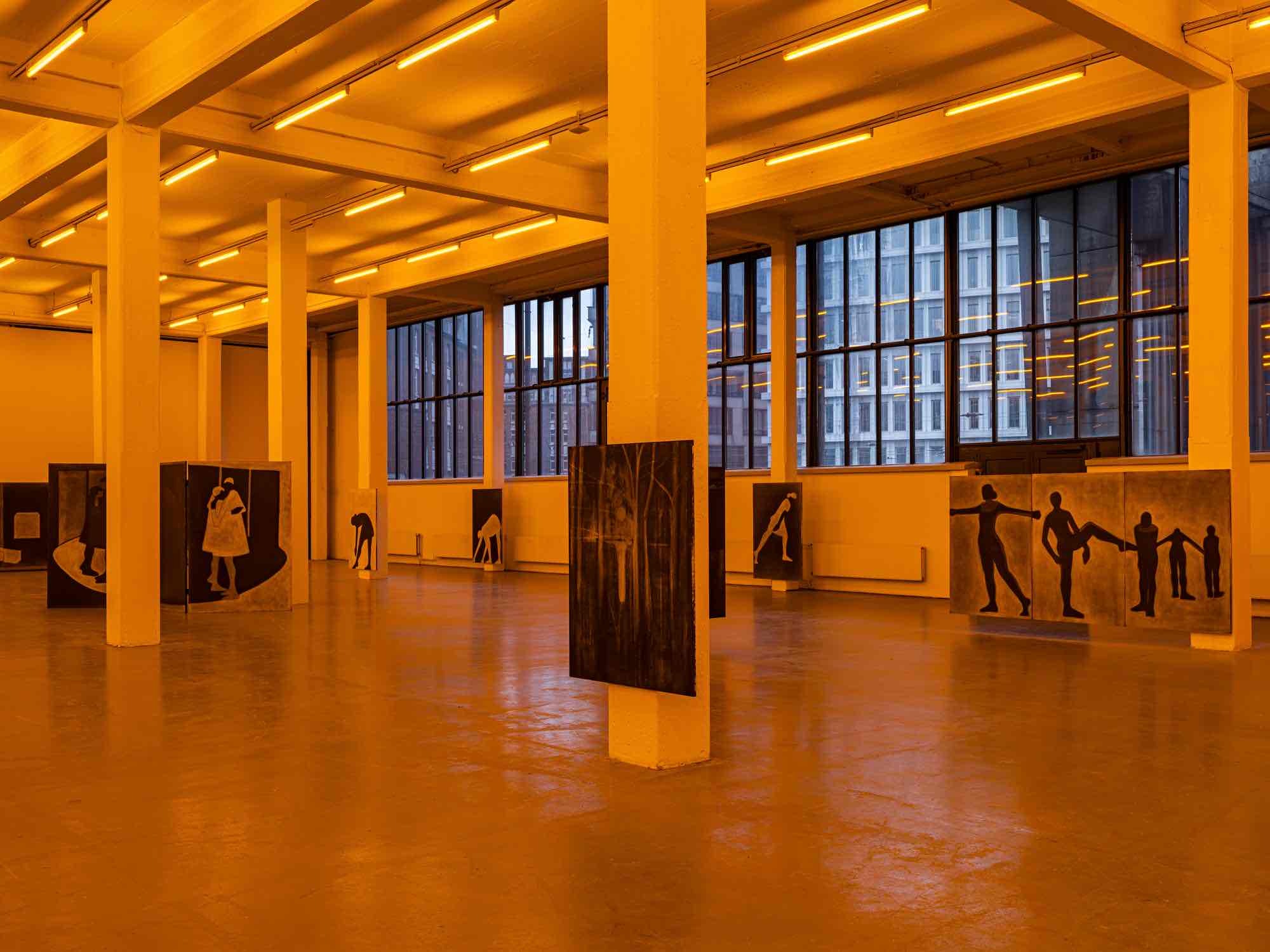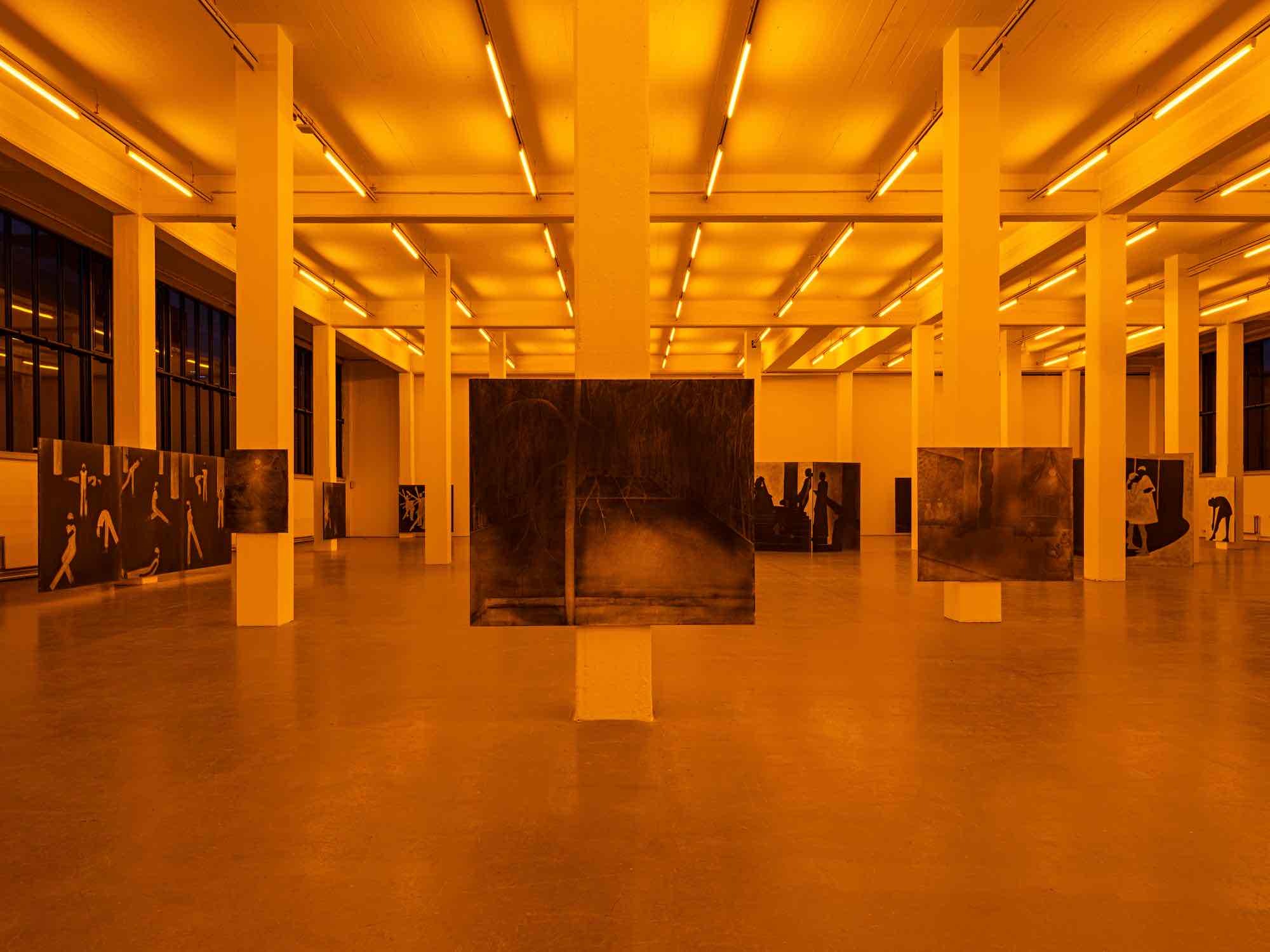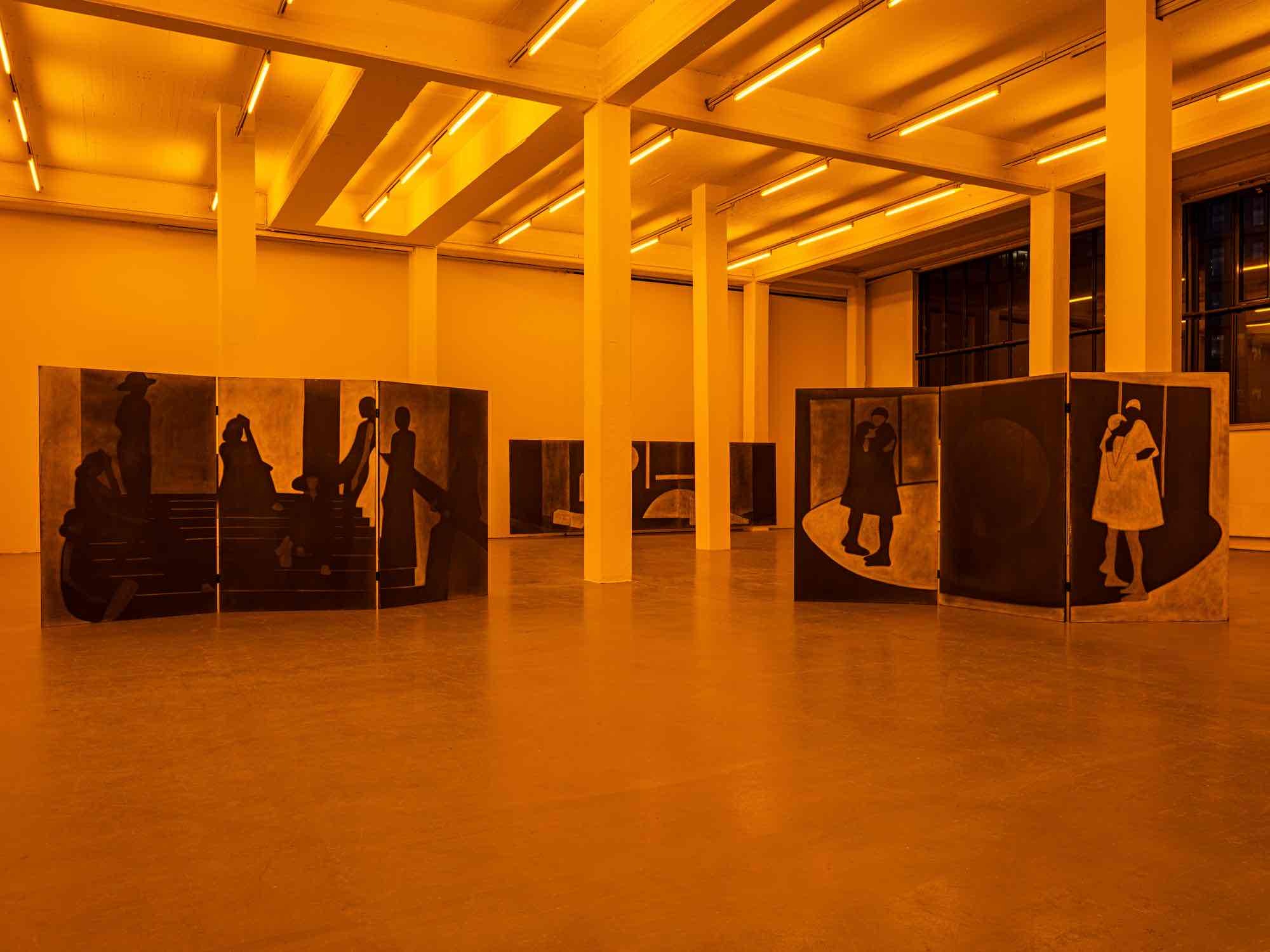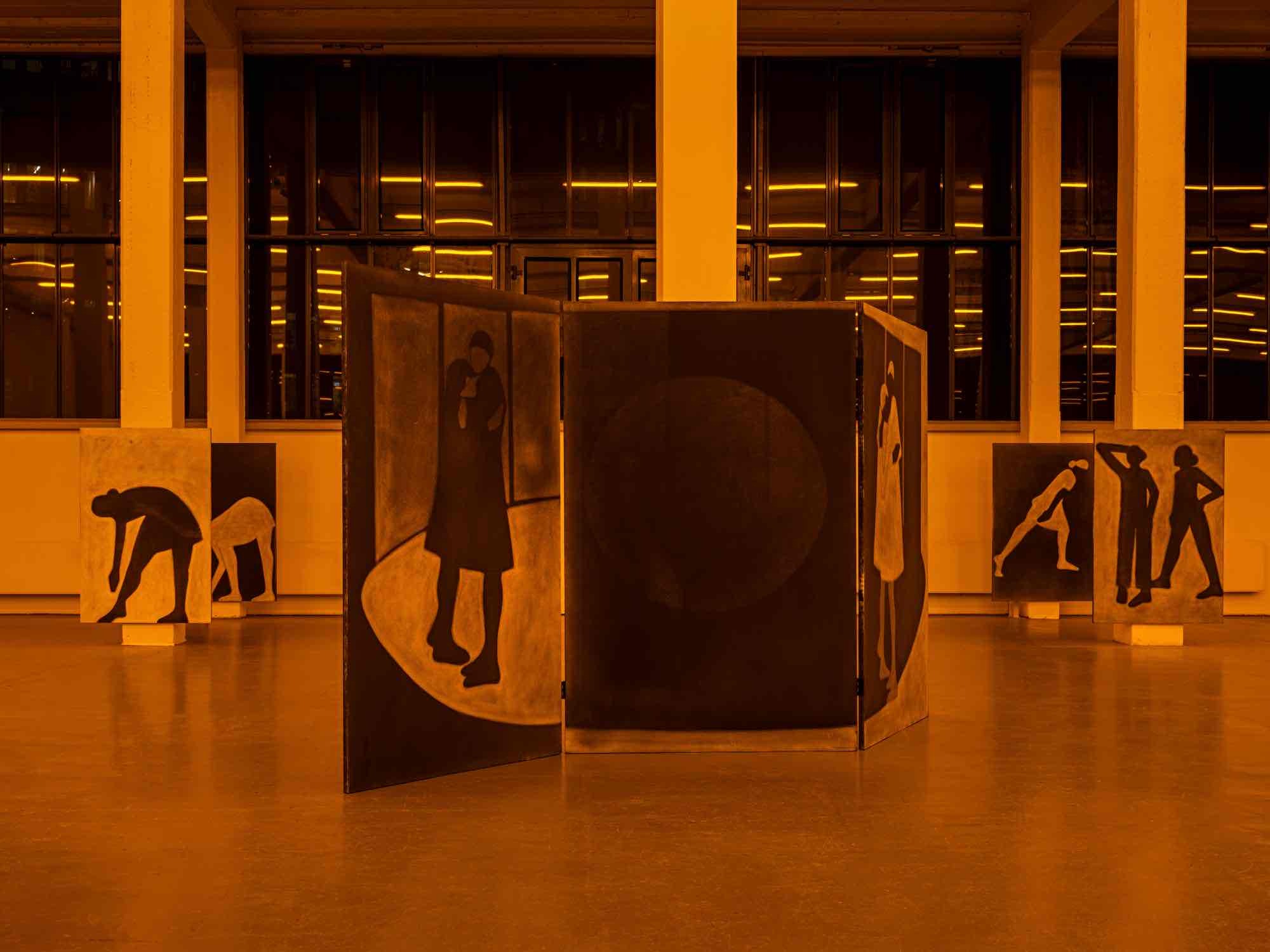Silke Otto-Knapp
Bühnenbilder
27 Jan - 14 Apr 2024
From the mid-1990s, Silke Otto-Knapp (1970–2022) developed a unique approach that both responds to and reflects on formal and thematic questions regarding the representation and embodiment of the performing arts within the medium of painting
Otto-Knapp’s final work cycle Versammlung (2022), which was conceived for the Kunstverein in Hamburg during the artist’s life, is central to Bühnenbilder. Here, the Lower Saxony-born artist delves into histories of theatre, dance and cinema, with a focus on forms of ritualised gathering on stage, while questioning the relationship between rehearsal and artistic practice, as well as performing and exhibiting. Versammlung will be shown in dialogue with Otto-Knapp’s work from the last decade, where Bühnenbilder pursues the formal developments from the individual work to the multi-panelled painting, to painting-as-architecture within an expansive wall-less choreography developed with Otto-Knapp for the Kunstverein.
Painted with watercolour pigments in high contrast greyscale Otto-Knapp’s depictions of theatre, dance, film and opera, from the single figure to the full proscenium, are present. The body of work in Bühnenbilder negotiates the relationship between figure and ground, between negative and positive space. Depth of space within the painting of Otto-Knapp becomes legible through choreographed bodies. It is precisely these bodies that are at the centre of a moment of tension: between the impossibility of representing movement in the medium of painting and the potentiality of the body in motion inherent in her work.
The choreographies, stages and costumes that Otto-Knapp draws upon such as those of Anna Halprin, Natalia Goncharova, Judson Dance Theatre or Michael Clark generate an extended and differentiated art history. Bühnenbilder identifies and gives body to performance art and avant-garde theatre as important currents and constitutive movements in contemporary art, thereby performing art history anew.
ANNA HALPRIN's Tanzbühne (Dance Stage) figures as the first work in the gallery of the exhibition. The dance stage was built in 1954 in Kentfield, Northern California, by set designer Arch Lauterer and Anna Halprin's husband Lawrence Halprin. It is not only surrounded by forest, but trees also grow through the stage boards, becoming integral to each performance. Breaking with conventions and the decentralized orientation of the stage creates a new tension between the audience, dancers, the overgrown architecture, and the space as a pedagogical environment. The landscape itself becomes part of the performance, leading to a multiple dissolution of the concept of stage. The lack of a clear orientation of the stage gives rise to what Halprin herself calls "active witnessing": traditional oppositions dissolve, and the audience becomes part of the performance. These dissolutions and the emergence of new stages are central themes in Otto-Knapp's œuvre.
In the series from 2020, which includes the works Figure and Group, Otto-Knapp gives new bodies to the choreographies of British choreographer MICHAEL CLARK by translating Clark's works into her own visual language. She negotiates the physicality of the figures, their gravity, and movement with reference to the history of ballet. Otto-Knapp shared a close and influential friendship with Clark.
In the mid-1920s, KURT SCHWITTERS developed his concept of the Normalbühne (Normal Stage), which was, however, never realized and exists only in drafts and memories. Influenced by the economic situation and the frugality of Constructivism, he aimed to create a stage whose set equipment could function for any text and any type of production using simple geometric forms. The arrangement and props allow for play with depth and illusions of space. In the five-part work Stage (after Kurt Schwitters) (2017), Otto-Knapp takes up these considerations and extends them in her mind with new combinations and constellations.
In Versammlung (Assembly), the three central, originally planned, freestanding, three-part works in the exhibition Bühnenbilder (Stage Designs), motifs from film, dance, and theater history are quoted. These include first, two figures from the choreographies of Spectodrama (1924-1936) by Xanti Schawinsky, with which Otto-Knapp references the Bauhaus dance. Secondly, a motif from Warnung vor einer heiligen Nutte (Warning of a Holy Whore) (1971) by RAINER WERNER FASSBINDER, or the stage play Fassbinder, Faust and the Animists (2017) staged by Michael Laub at Theater Hebbel am Ufer. In this scene, during the filming of a movie within the movie or a film on stage, a gathering of actors on a staircase anticipates their own entrance in an intermediate state. The tiles in the exhibition's foyer also reference Laub and Fassbinder. Finally, photos from the 1930s of a production of BERTOLD BRECHT's Dreigroschenoper (The Threepenny Opera) (1930), a motif where the two embracing figures almost merge into one.
The three-part picture In the midnight hour (2017) raises questions about the indistinguishability of practice and performance within the image. It depicts a scene of preparing for a performance, which itself becomes part of a performance on the pictorial stage - an activity that typically escapes the audience's attention. It is a scene of collective learning, the establishment of relationships among participants, where the positioning of bodies creates a new space. This practice is a technique of inscribing scores into the bodies of the dancers, a process of internalization that yields the bodies of the dancers. The complex choreographic movements, initially still executed with concentration, inscribe themselves in the dancers' bodies through practice.
The two works Stage (YSL, spring/summer 1988; Braque collection; doves, guitars) and Stage II (YSL, fall/winter 1966) (both 2016) refer to collections by the fashion designer YVES SAINT LAURENT, who incorporated motifs from American painter Tom Wesselmann and French painter/graphic artist Georges Braque into his collections. Here, Otto-Knapp points to the affective power of these collective symbols, including the sun, the moon, and the heart. Additionally, the moon is a recurring motif in Otto-Knapp's works, serving as an object of stage direction. Furthermore, the costume is a potential stage for the body as a medium of performance - whether in everyday life or on a fashion runway.
Curated by Milan Ther
Otto-Knapp’s final work cycle Versammlung (2022), which was conceived for the Kunstverein in Hamburg during the artist’s life, is central to Bühnenbilder. Here, the Lower Saxony-born artist delves into histories of theatre, dance and cinema, with a focus on forms of ritualised gathering on stage, while questioning the relationship between rehearsal and artistic practice, as well as performing and exhibiting. Versammlung will be shown in dialogue with Otto-Knapp’s work from the last decade, where Bühnenbilder pursues the formal developments from the individual work to the multi-panelled painting, to painting-as-architecture within an expansive wall-less choreography developed with Otto-Knapp for the Kunstverein.
Painted with watercolour pigments in high contrast greyscale Otto-Knapp’s depictions of theatre, dance, film and opera, from the single figure to the full proscenium, are present. The body of work in Bühnenbilder negotiates the relationship between figure and ground, between negative and positive space. Depth of space within the painting of Otto-Knapp becomes legible through choreographed bodies. It is precisely these bodies that are at the centre of a moment of tension: between the impossibility of representing movement in the medium of painting and the potentiality of the body in motion inherent in her work.
The choreographies, stages and costumes that Otto-Knapp draws upon such as those of Anna Halprin, Natalia Goncharova, Judson Dance Theatre or Michael Clark generate an extended and differentiated art history. Bühnenbilder identifies and gives body to performance art and avant-garde theatre as important currents and constitutive movements in contemporary art, thereby performing art history anew.
ANNA HALPRIN's Tanzbühne (Dance Stage) figures as the first work in the gallery of the exhibition. The dance stage was built in 1954 in Kentfield, Northern California, by set designer Arch Lauterer and Anna Halprin's husband Lawrence Halprin. It is not only surrounded by forest, but trees also grow through the stage boards, becoming integral to each performance. Breaking with conventions and the decentralized orientation of the stage creates a new tension between the audience, dancers, the overgrown architecture, and the space as a pedagogical environment. The landscape itself becomes part of the performance, leading to a multiple dissolution of the concept of stage. The lack of a clear orientation of the stage gives rise to what Halprin herself calls "active witnessing": traditional oppositions dissolve, and the audience becomes part of the performance. These dissolutions and the emergence of new stages are central themes in Otto-Knapp's œuvre.
In the series from 2020, which includes the works Figure and Group, Otto-Knapp gives new bodies to the choreographies of British choreographer MICHAEL CLARK by translating Clark's works into her own visual language. She negotiates the physicality of the figures, their gravity, and movement with reference to the history of ballet. Otto-Knapp shared a close and influential friendship with Clark.
In the mid-1920s, KURT SCHWITTERS developed his concept of the Normalbühne (Normal Stage), which was, however, never realized and exists only in drafts and memories. Influenced by the economic situation and the frugality of Constructivism, he aimed to create a stage whose set equipment could function for any text and any type of production using simple geometric forms. The arrangement and props allow for play with depth and illusions of space. In the five-part work Stage (after Kurt Schwitters) (2017), Otto-Knapp takes up these considerations and extends them in her mind with new combinations and constellations.
In Versammlung (Assembly), the three central, originally planned, freestanding, three-part works in the exhibition Bühnenbilder (Stage Designs), motifs from film, dance, and theater history are quoted. These include first, two figures from the choreographies of Spectodrama (1924-1936) by Xanti Schawinsky, with which Otto-Knapp references the Bauhaus dance. Secondly, a motif from Warnung vor einer heiligen Nutte (Warning of a Holy Whore) (1971) by RAINER WERNER FASSBINDER, or the stage play Fassbinder, Faust and the Animists (2017) staged by Michael Laub at Theater Hebbel am Ufer. In this scene, during the filming of a movie within the movie or a film on stage, a gathering of actors on a staircase anticipates their own entrance in an intermediate state. The tiles in the exhibition's foyer also reference Laub and Fassbinder. Finally, photos from the 1930s of a production of BERTOLD BRECHT's Dreigroschenoper (The Threepenny Opera) (1930), a motif where the two embracing figures almost merge into one.
The three-part picture In the midnight hour (2017) raises questions about the indistinguishability of practice and performance within the image. It depicts a scene of preparing for a performance, which itself becomes part of a performance on the pictorial stage - an activity that typically escapes the audience's attention. It is a scene of collective learning, the establishment of relationships among participants, where the positioning of bodies creates a new space. This practice is a technique of inscribing scores into the bodies of the dancers, a process of internalization that yields the bodies of the dancers. The complex choreographic movements, initially still executed with concentration, inscribe themselves in the dancers' bodies through practice.
The two works Stage (YSL, spring/summer 1988; Braque collection; doves, guitars) and Stage II (YSL, fall/winter 1966) (both 2016) refer to collections by the fashion designer YVES SAINT LAURENT, who incorporated motifs from American painter Tom Wesselmann and French painter/graphic artist Georges Braque into his collections. Here, Otto-Knapp points to the affective power of these collective symbols, including the sun, the moon, and the heart. Additionally, the moon is a recurring motif in Otto-Knapp's works, serving as an object of stage direction. Furthermore, the costume is a potential stage for the body as a medium of performance - whether in everyday life or on a fashion runway.
Curated by Milan Ther

